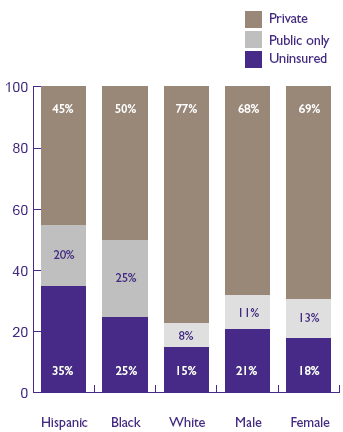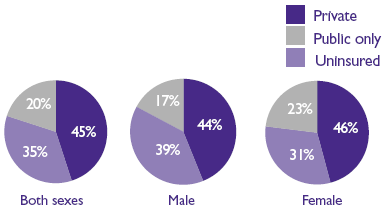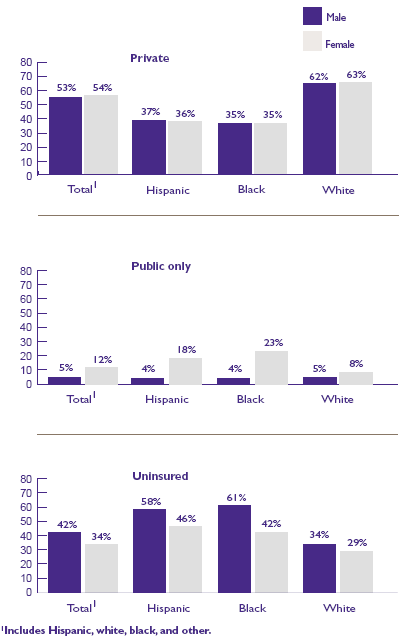Highlights #6: Health Insurance Profile: Race/Ethnicity and Sex, 1996
Estimates for the U.S.
Civilian Noninstitutionalized Population Under 65
Introduction
Data from the 1996 Medical Expenditure
Panel Survey (MEPS) of the Agency for Health Care Research and
Quality (AHRQ) show that health insurance status among people
under 65 varies according to demographic characteristics such
as race/ethnicity and sex. Figure 1 shows that, in the first
half of 1996, half of all non-elderly blacks (50 percent) and
less than half of all Hispanics (45 percent) were covered by
private health insurance, compared with more than three-quarters
of whites (77 percent).
The converse is true for persons covered only
by public insurance. Compared with non-elderly whites (8 percent),
more than twice as many Hispanics (20 percent) and three times
as many blacks (25 percent) had only public coverage. Yet even
with a higher proportion of minorities than whites on public
insurance, minorities had a greater risk of being uninsured.
Hispanics were the most likely to lack health insurance (35 percent,
compared with 25 percent of blacks and 15 percent of whites).
^top
Briefly Stated
- Among Americans under 65, more than a third
of Hispanics (35 percent) and a quarter of blacks (25 percent)
were uninsured during the first half of 1996, compared with
only 15 percent of whites. Of all sex-race/ethnicity groups,
Hispanic males were the most likely to be uninsured (39 percent).
- Half of all non-elderly blacks (50 percent)
and less than half of all Hispanics (45 percent) had private
health insurance. In contrast, more than three-quarters of
whites (77 percent) were privately insured.
- The rate of coverage by only public insurance
among people under 65 was more than twice as high for blacks
and Hispanics (25 percent and 20 percent, respectively) as
for whites (8 percent).
- Overall, only slightly over half of all
young adults ages 19-24 (53 percent) were covered by private
health insurance.
- Among young adults ages 19-24, men and women
were equally likely to have private insurance.
- Among minorities ages 19-24, women were
more likely than men to have public insurance, so more men
were uninsured. In this age group, about 60 percent of all
minority men were uninsured.
^top
MEPS
Definitions of Private and Public Insurance
The term private health insurance refers
only to health insurance that provides coverage for hospital
and physician care. Insurance that provides coverage for a single
service only, such as dental or vision coverage, is not counted
as private insurance.
Individuals are considered to have public
insurance if they have coverage only under Medicare, Medicaid,
CHAMPUS/CHAMPVA (Civilian Health and Medical Programs for the
Uniformed Services and Veterans' Affairs), or another type
of public coverage for hospital and physician care.
^top
Race/Ethnicity
and Sex
Non-elderly males and females were equally
likely to be covered by private health insurance (Figure
1). Nevertheless, because females were more likely than males
to be covered by public insurance, they were less likely to be
uninsured (18 percent vs. 21 percent). This pattern is especially
evident among Hispanics (Figure 2).
Among non-elderly Hispanics, males and females were equally likely
to be covered by private insurance, but more females (23 percent)
than males (17 percent) had public coverage. Therefore, fewer
Hispanic females were uninsured (31 percent, compared with 39
percent of Hispanic males).
A pattern of insurance coverage similar to
that for all non-elderly persons emerges for young adult men
and women ages 19-24, although the differences in coverage are
more marked. Young adults of both sexes were equally likely to
have private health insurance coverage. However, Figure 3 shows
that young women were more than twice as likely as young men
to have only public coverage (12 percent and 5 percent, respectively),
so fewer young women were uninsured (34 percent of women versus
42 percent of men).
These disparities in coverage for young adults
were even more pronounced among minorities (Figure
3). Among young adults, black women were five times as likely
as black men to obtain public insurance, and Hispanic women were
four times as likely as Hispanic men to have public coverage.
This translates into higher uninsured rates among young minority
men than women. The most dramatic difference is seen among blacks
ages 19-24, where 61 percent of young men but only 42 percent
of young women were uninsured.
^top
About MEPS
The Medical Expenditure Panel Survey (MEPS)
collects nationally representative data on health care use, expenditures,
source of payment, and insurance coverage for the U.S. civilian
noninstitutionalized population. MEPS is cosponsored by the Agency
for Health Care Research and Quality (AHRQ) and the National Center
for Health Statistics. This Highlights summarizes data concerning
variations in health insurance status by sex and race/ethnicity
in the United States during the first half of 1996, as derived
from the MEPS Household Component, Round 1. For more information
about MEPS, see the sources listed on the back page.
^top
Figures
Figure 1.
Persons under age 65--health insurance status by race/ethnicity
and sex: First half of 1996

- Hispanics were more
likely than blacks or whites to be uninsured.
DATA
SOURCE: 1996 Medical Expenditure
Panel Survey Household Component, Round 1.
^top
Figure 2. Hispanics
under age 65--health insurance status: First half of 1996

- Rates of private insurance
were about the same for Hispanic males and females, but rates
of public insurance and lack of insurance showed more gender
disparity.
DATA SOURCE: 1996
Medical Expenditure Panel Survey Household Component, Round 1.
^top
Figure 3. Young
adults ages 19-24--health insurance status: First half of
1996

- About 60 percent of all minority men
ages 19-24 were uninsured.
1 Includes
Hispanic, white, black, and other.
DATA
SOURCE: 1996 Medical Expenditure
Panel Survey Household Component, Round 1.
^top
References
For more information about MEPS, call the MEPS
information coordinator at AHRQ (301-594-1406) or visit the MEPS
section of the AHRQ Web site at: http://www.ahrq.gov/
For a detailed description of the MEPS survey
design, sample design, and methods used to reduce sources of
nonsampling error, see the following publications:
Cohen J. Design and methods of the Medical
Expenditure Panel Survey Household Component. Rockville (MD):
Agency for Health Care Policy and Research; 1997. MEPS Methodology
Report No. 1. AHRQ Pub. No. 97-0026.
Cohen S. Sample design of the 1996 Medical
Expenditure Panel Survey Household Component. Rockville (MD):
Agency for Health Care Policy and Research; 1997. MEPS Methodology
Report No. 2. AHRQ Pub. No. 97-0027.
The estimates in this Highlights are
based on the following, more detailed publication:
Vistnes JP, Monheit AC. Health insurance status
of the civilian noninstitutionalized population: 1996. Rockville
(MD): Agency for Health Care Policy and Research; 1997. MEPS
Research Findings No. 1. AHRQ Pub. No. 97-0030.
These publications are available from the
AHRQ Clearinghouse (800-358-9295) and on the AHRQ Web site.
MEPS Highlights
No. 6, AHRQ Pub. No. 98-0052, September 1998.
Suggested Citation:
Highlights #6: Health Insurance Profile: Race/Ethnicity and Sex, 1996. September 1998. Agency for Healthcare Research and Quality, Rockville, MD.
http://www.meps.ahrq.gov
/data_files/publications/hl6/hl6.shtml
|
|
